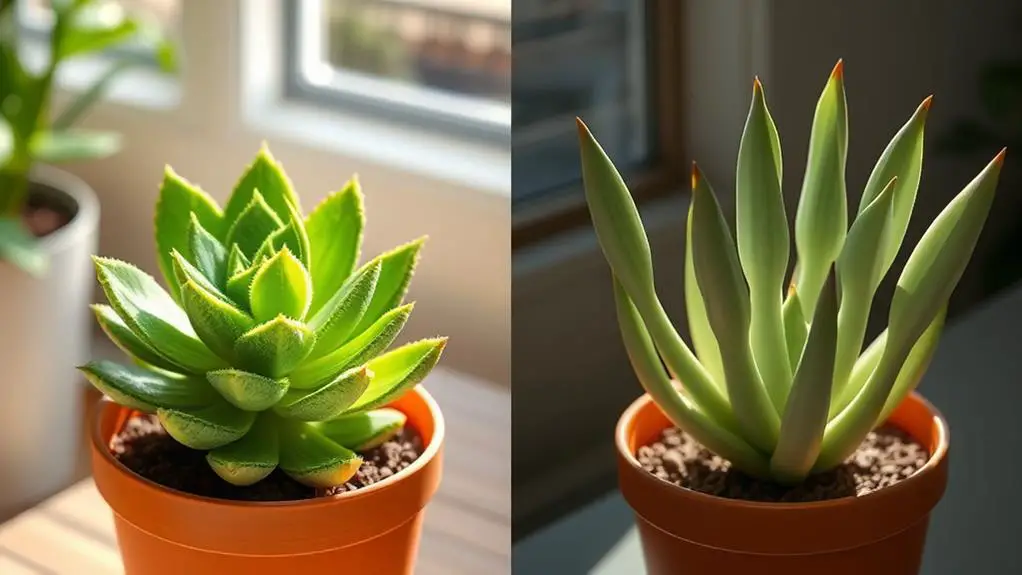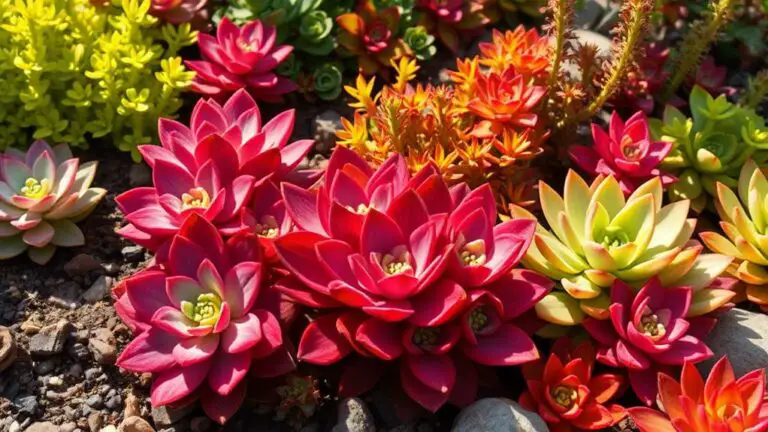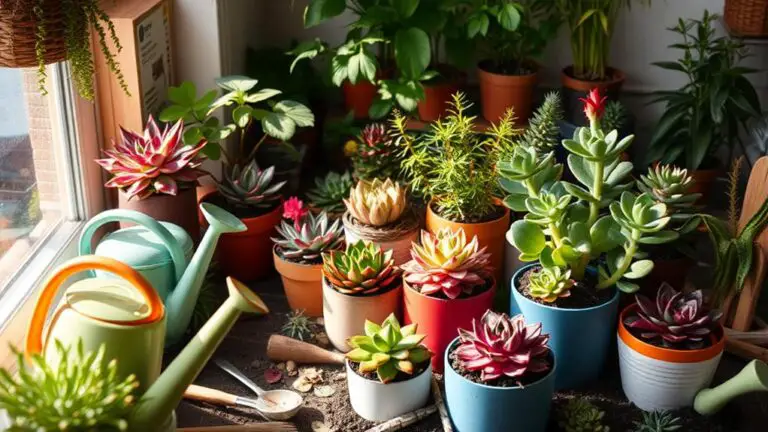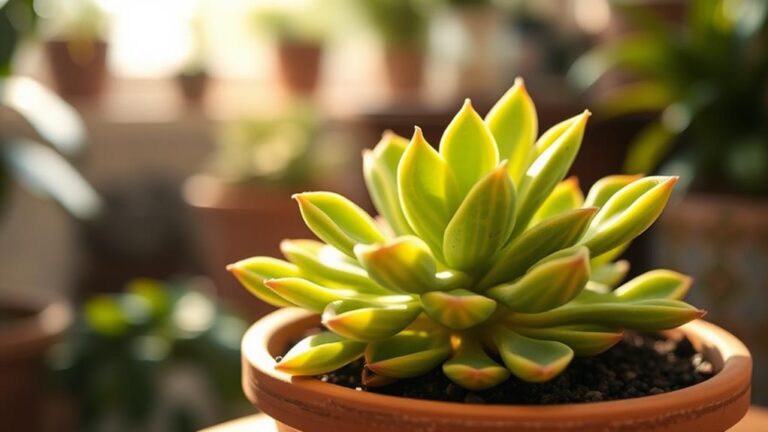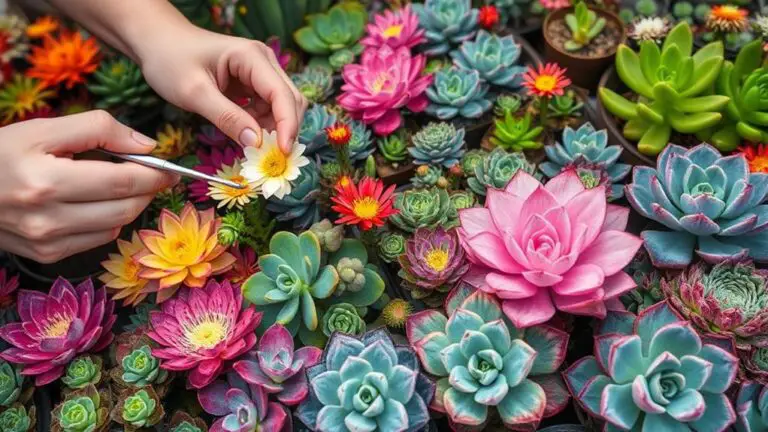Troubleshooting Common Light Problems in Succulents
When you're caring for succulents, identifying light problems early is essential for their health. You might notice elongated stems or pale leaves, signaling insufficient light, or see brown patches indicating too much sun. Correcting these issues involves more than just moving your plant; you need to take into account gradual exposure and even light distribution. Have you thought about how seasonal changes affect your plant's light requirements? Understanding these nuances will help maintain your succulents' vibrant growth. Let's explore the steps to guarantee your plants thrive in the right conditions.
Identifying Light Issues
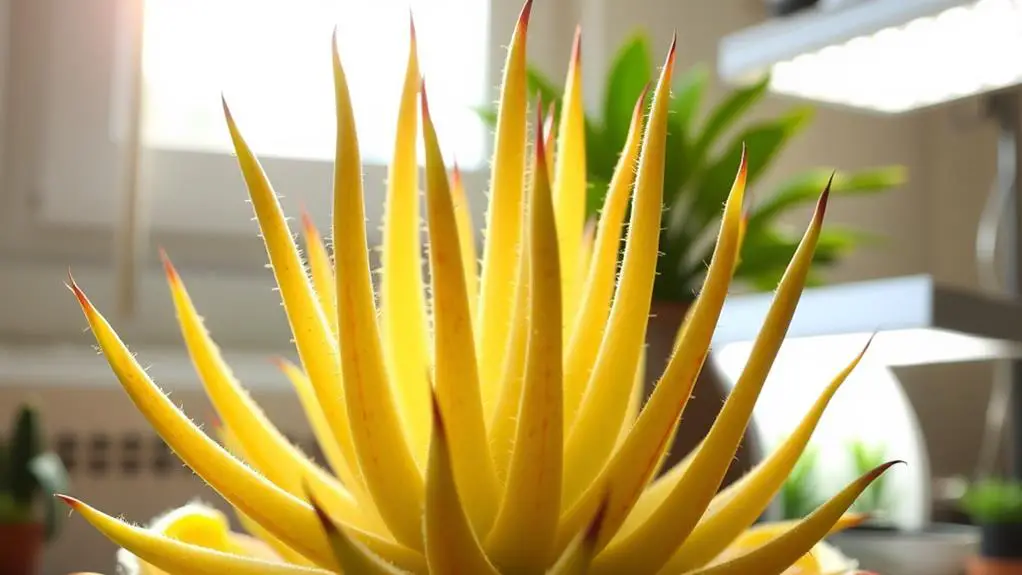
When your succulents start showing elongated stems and pale leaves, they're signaling that they're not getting enough light. Insufficient light makes them stretch towards the nearest light source, resulting in leggy appearances. This isn't ideal for the health or aesthetics of your plants.
To address this, consider moving your succulents to a location with brighter light. South or east-facing windows are often best since they provide ample sunlight without the intensity that can cause damage.
However, it's important to be cautious of overexposure. Too much direct sunlight can lead to brown or tan patches on the leaves, known as sunburn, which can cause irreversible damage and even leaf drop.
Gradually acclimating your succulents to higher light levels over a few weeks can help prevent shock. This method allows your plants to adapt without suffering from the sudden change.
Additionally, regularly rotating your planters promotes even light exposure, fostering balanced growth and preventing one-sided stretching.
Symptoms of Insufficient Light
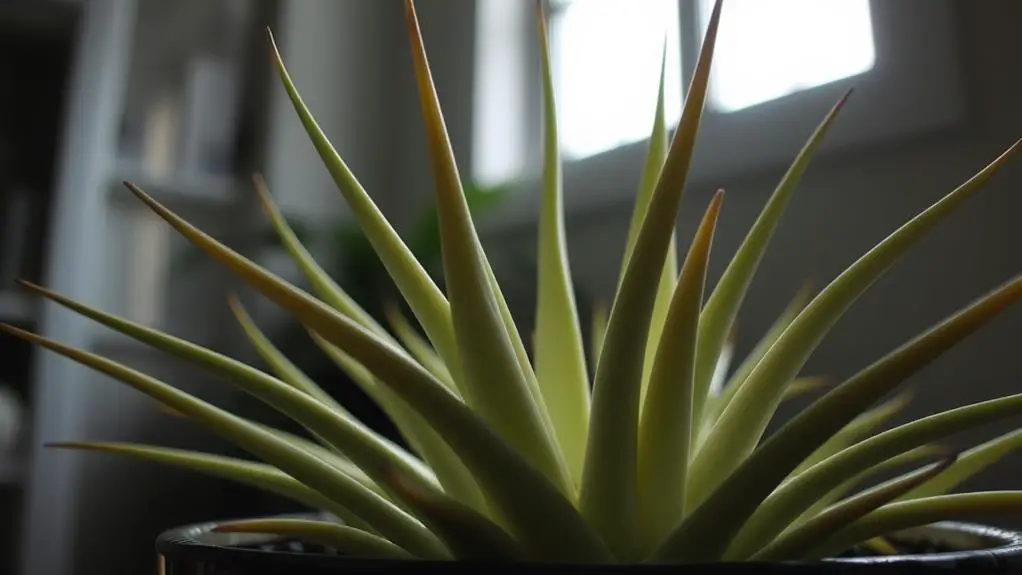
Lack of sufficient light manifests in succulents through several telltale signs. You may notice your succulents starting to grow in a spindly manner as they stretch towards the nearest light source. This elongated growth happens because they're desperately reaching for more light.
Healthy succulents should have a compact shape, but with insufficient light, their rosettes may flatten out and appear less dense.
Another clear indicator is the color and condition of the leaves. If your succulent's leaves are pale or dull, it's a sign they're not getting enough light for proper photosynthesis. In some cases, you might even see leaves dropping off or becoming soft and mushy. This happens because the plant isn't producing enough energy to maintain its health.
To keep your succulents thriving, they need at least 10 hours of bright, indirect light each day. Placing them near a sunny window can help, but make sure they're not exposed to harsh, direct sunlight.
Symptoms of Excessive Light
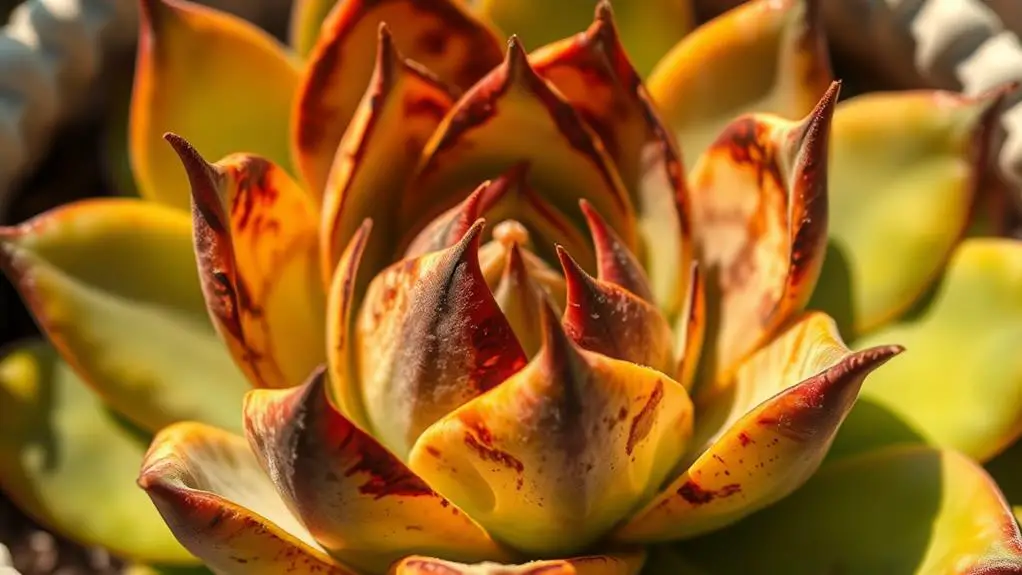
Succulents can frequently suffer from excessive light exposure, which manifests through several distinct symptoms. When your succulents get too much sun, you might notice brown or tan patches on their leaves or stems. This is sunscald damage indicating that the intense sunlight is too harsh for your plants.
Here are some key symptoms to watch out for:
- Brown patches: These patches appear on leaves or stems due to sunburn.
- Sudden leaf damage: If your plant was in low light and suddenly gets bright light, its leaves can get damaged quickly.
- Leaf drop: Sunburned leaves won't recover and will usually fall off as the plant grows new ones.
Be mindful that succulents need time to adjust to new light conditions.
Gradual acclimatization to sunlight is vital because sudden changes can be harmful. Most succulents do best in bright, indirect light rather than direct, harsh sunlight. If you expose them to too much direct afternoon sun, especially sensitive varieties, they can experience more severe damage.
Monitoring the light conditions your succulents are exposed to will help prevent these issues and keep your plants healthy and thriving.
Correcting Light Deficiency
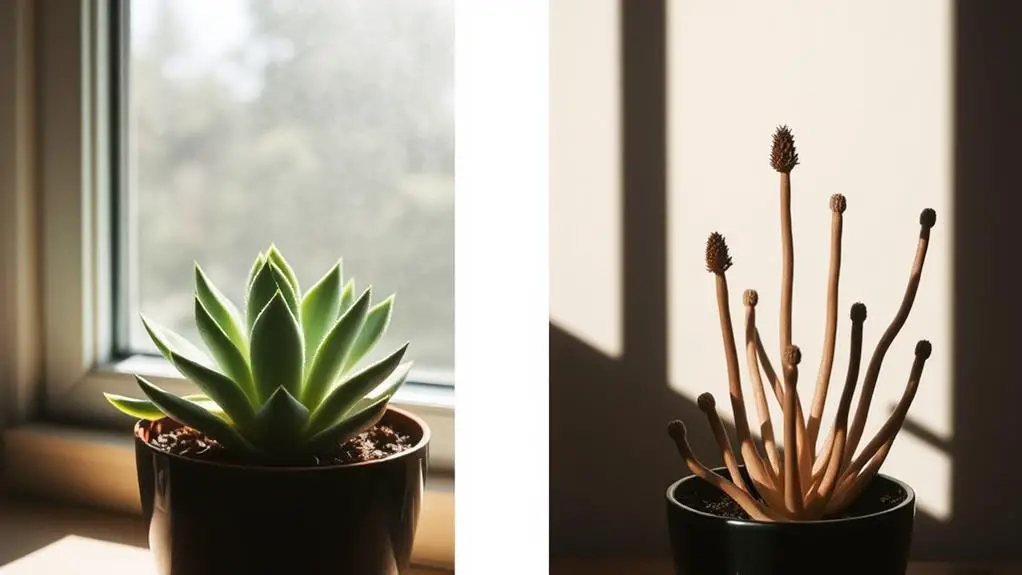
Correcting light deficiency in succulents is crucial for their overall health and growth. When your succulents aren't getting enough light, they can become stretched and pale, signaling insufficient exposure.
Start by gradually increasing sunlight exposure. Move your plants from full shade to partial sun, then to full sun over several weeks, so they can adapt without shock.
Succulents thrive in bright, indirect light for at least 10 hours a day. If natural light is insufficient, consider using full-spectrum grow lights to supplement it. These grow lights mimic natural sunlight and help your plants receive the light they need.
Make certain to rotate your planters weekly. This guarantees even light exposure on all sides, promoting balanced growth. By doing this, you'll avoid your succulents leaning towards a single light source.
If you're moving your succulents outdoors, acclimate them slowly to prevent sunburn. Start by placing them in partial shade and gradually increase their sun exposure. This helps them adjust without getting damaged by sudden, intense sunlight.
Preventing Sunburn
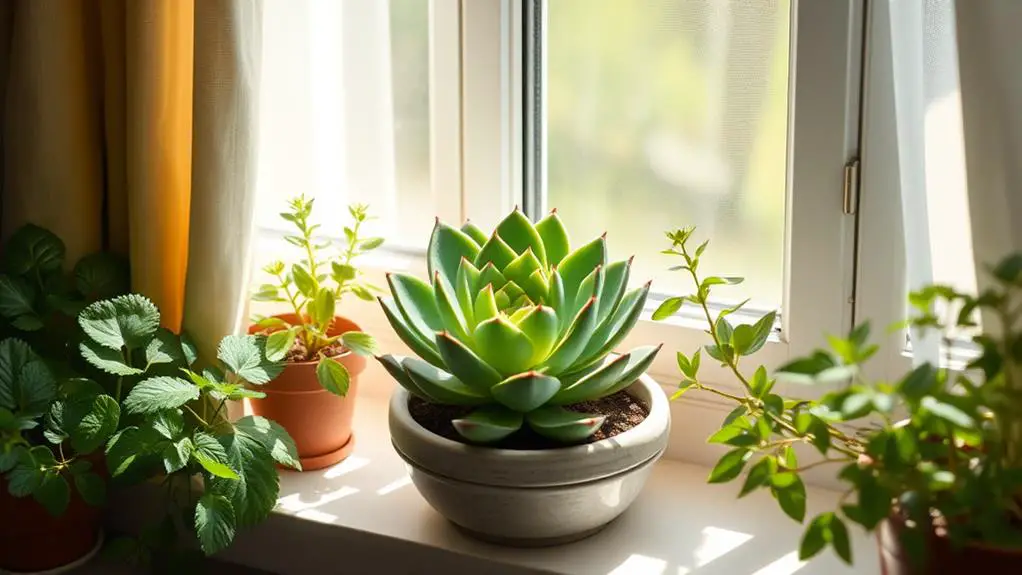
Preventing sunburn in succulents is an essential part of their care routine. To keep your succulents healthy and vibrant, you need to be careful about their exposure to sunlight. Here are some key steps to prevent sun damage:
- Acclimate gradually: Slowly introduce your succulents to more sunlight over a few weeks. Start them in shaded areas and gradually move them to spots with more light to avoid shock.
- Use bright indirect sunlight: Most succulents thrive in bright, indirect sunlight. Thin curtains or placing them behind glass can filter harmful UV rays while still giving them the light they need.
- Monitor for signs of sunburn: Watch your succulents closely for brown or tan patches on their leaves, especially during peak sunlight hours when the sun's intensity is highest.
Regularly rotate your succulents to guarantee even sun exposure and prevent one-sided growth. Each species has different light requirements, so consider the specific needs of your plant.
Some succulents are more prone to sunburn and need extra care in their placement and monitoring. By following these steps, you can protect your succulents from sun damage and keep them looking their best.
Indoor Light Solutions
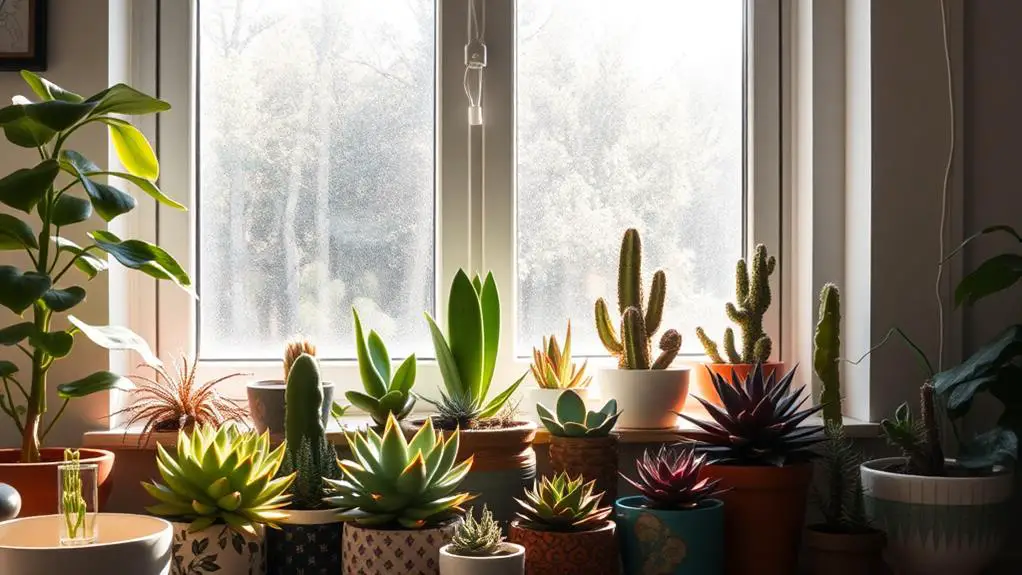
When growing succulents indoors, it's essential to provide them with at least 10-12 hours of bright, indirect light each day, ideally placing them near south or east-facing windows.
If natural light isn't enough, consider using full-spectrum grow lights to mimic sunlight and support healthy growth.
To keep your succulents from stretching, gradually increase their light exposure and rotate them regularly for even light distribution.
Optimal Light Sources
For maintaining healthy succulents indoors, it's essential to provide adequate light. Succulents need bright indirect sunlight for ideal light exposure. Placing them near south or east-facing windows usually works best.
If natural light isn't enough, you can use full-spectrum grow lights. These are designed to mimic sunlight and can help prevent stretching and other signs of light stress.
Here are some tips to keep your succulents thriving:
- Rotate your succulents regularly: This guarantees even light distribution and prevents them from leaning towards the light.
- Monitor for signs of light stress: Look for elongated stems or pale leaves, which indicate a need for more light.
- Use full-spectrum grow lights: These lights can supplement natural light, especially during darker months or in rooms with limited sunlight.
Make certain to gradually increase their exposure to brighter light to avoid shocking your plants. Start with a few hours a day and increase it over weeks.
Acclimating to Light
While providing ideal light sources is key, acclimating your succulents to these conditions is just as important. Start by gradually increasing their exposure to light over several weeks. Move your succulents from shade to partial sun, and then finally to full sun. This gradual increase helps prevent shock and sunburn.
Monitor your plants closely during this process. Look for signs of stress such as elongated stems or pale leaves. These signs usually indicate that your succulents aren't getting enough light. If natural light is insufficient, utilize grow lights with a full-spectrum output. Provide at least 10-12 hours of light daily for peak growth.
Rotate your planters weekly to guarantee even light distribution on all sides of the plant. This practice promotes balanced growth and prevents your succulents from leaning towards the light source.
Be cautious of sudden increases in light intensity, especially if your plants have been in low light for a while. Sudden changes can lead to sunburn and cause irreversible damage to the leaves.
Supplemental Lighting Options
Finding the right supplemental lighting options for your indoor succulents can make a world of difference in their health and growth. Sometimes, natural light isn't enough, especially in low light conditions.
Here are some effective solutions to help your succulents thrive:
- Full-spectrum grow lights: These lights closely mimic natural sunlight and are perfect for promoting healthy growth. They help prevent wrinkled leaves and keep your plants looking vibrant.
- LED grow lights: Energy-efficient and cool, LED grow lights provide sufficient light for photosynthesis without overheating your succulents. They're ideal for indoor setups.
- Fluorescent lights (T5 bulbs): These bulbs are affordable and offer good light output. They're a great option if you're on a budget but still want your succulents to receive the light they need.
Position your grow lights about 12-18 inches above your succulents. This guarantees they get enough light without causing heat stress or burning their leaves.
Use a timer to simulate natural daylight cycles, giving your plants 10-14 hours of light daily. Remember to always water when the soil is dry and use well-draining soil to keep your succulents healthy.
With the right lighting, you'll see your succulents flourish even indoors!
Optimal Light Conditions
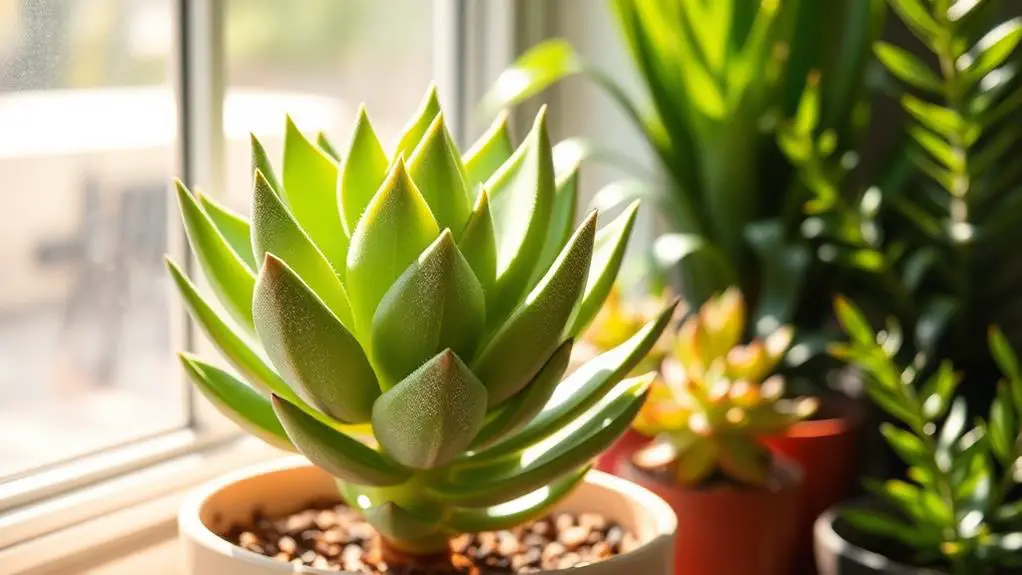
Thriving succulents require the right light conditions to stay healthy and vibrant. To provide ideal light conditions, place your succulents in bright, indirect sunlight for at least 10 hours a day. Direct sunlight can lead to sunburn and damage, so it's best to avoid it. A south or east-facing window works perfectly, offering a good mix of warmth and brightness without the harsh afternoon sun.
If your succulents aren't getting enough light, you'll notice them stretching and becoming leggy. This is a sign they need more light. Moving them to a brighter spot can help, but remember to do it gradually. Increase their exposure over several weeks to prevent shock and stress.
During winter or in areas with limited natural light, full-spectrum grow lights can be a great help. These lights supplement natural light and guarantee your succulents get what they need to grow healthy and strong.
Placing the grow lights above your plants and setting them on a timer can mimic the natural light cycle, giving your succulents the best chance to thrive no matter the season. By following these tips, you'll keep your succulents looking their best all year round.
Seasonal Light Adjustments

As you've established ideal light conditions for your succulents, it's important to recognize that these conditions aren't static throughout the year.
Seasonal light adjustments are vital. As seasons change, the intensity and duration of sunlight can considerably affect your succulents' growth, so you'll need to make some changes to guarantee they're getting adequate light.
During winter months, the days are shorter and natural light is weaker. Move your succulents closer to windows or use supplemental grow lights to make up for the loss of daylight. This helps prevent them from becoming leggy and weak.
In summer, strong sunlight can be too much. Watch for signs of sunburn, like brown or white patches on the leaves. Position your plants to avoid harsh afternoon rays but still keep them in bright, indirect light.
As spring arrives, gradually acclimate your succulents to increased sunlight. This prevents shock and encourages healthy growth as the days get longer.
To keep your succulents happy all year:
- Rotate pots regularly for even light exposure.
- Adjust placement based on seasonal light changes.
- Use grow lights in winter and provide shade in summer.
Monitoring Plant Response
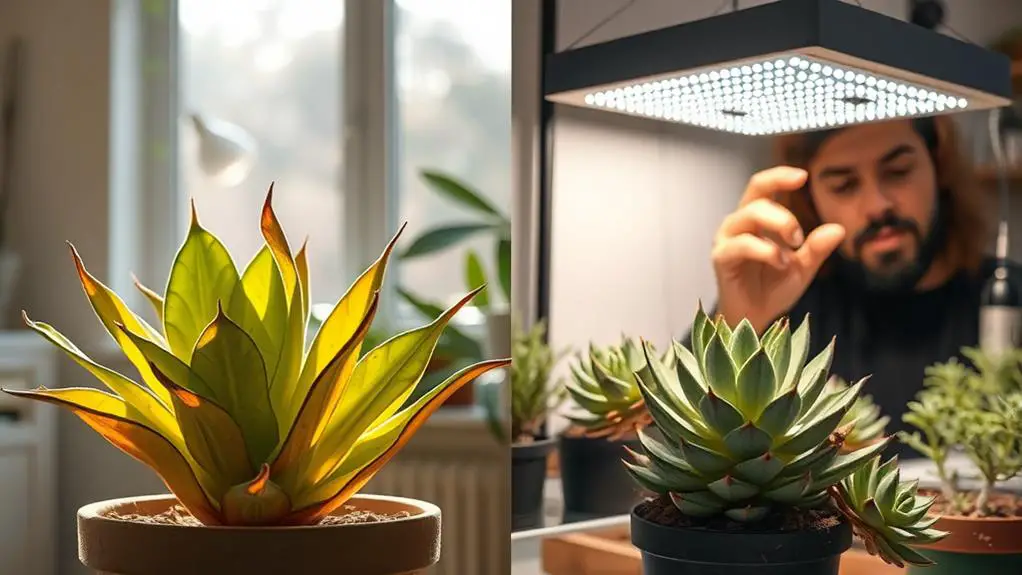
To guarantee your succulents are getting the right amount of light, regularly observe their growth patterns and leaf color. If you notice your plants are stretching or developing leggy stems, it's a sign that light is lacking. These inadequate light conditions mean you might need to relocate your succulents to a brighter spot.
Monitor leaf color changes to understand your succulent's needs better. Pale leaves often indicate that light is lacking, while brown or scorched leaves suggest too much direct sunlight. Aim for at least 10 hours of bright indirect light daily to keep your succulents thriving.
Don't forget to rotate your planters weekly. This simple habit guarantees even sunlight exposure, preventing one-sided growth and helping your plants maintain a balanced shape.
Observing leaf texture and firmness is also essential. Wrinkled leaves can signal underwatering, often caused by inadequate light conditions affecting the plant's water uptake.
Tips for Healthy Growth
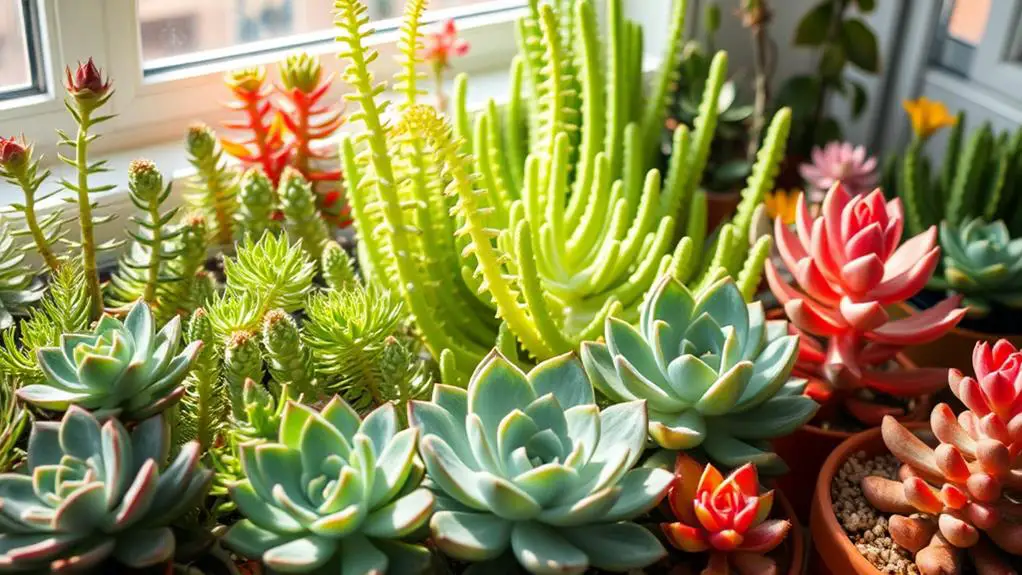
To guarantee your succulents grow healthy and strong, place them where they can get bright, indirect light for at least 10 hours each day.
Gradually increase their light exposure to prevent sun damage, starting with partial sunlight and slowly moving to full sun over several weeks.
Rotate the pots weekly so all sides of your succulents receive even light, promoting balanced growth.
Optimal Light Conditions
For succulents to thrive, providing them with ideal light conditions is essential. Succulents need bright, indirect light for at least 10 hours daily. Placing them near south or east-facing windows will give them the best chance for healthy growth.
Here are some tips to guarantee your succulents receive the best light they need:
- Gradually increase light exposure: Slowly acclimate your succulents to brighter light over several weeks to prevent shock.
- Rotate planters weekly: This guarantees even light distribution, helping your succulents grow evenly and preventing them from leaning towards a light source.
- Use full-spectrum grow lights: In winter or low-light environments, supplement with grow lights to maintain healthy growth.
If you notice elongated stems or pale leaves, your succulent is signaling that it's not getting enough light.
Adjust its placement to a brighter spot, but be careful not to expose it to direct sunlight all at once.
Prevent Sun Damage
Keeping your succulents healthy involves preventing sun damage, which can be tricky given their need for bright light. To safeguard your plants, start by monitoring them for signs of sun damage like brown or tan patches. These patches indicate too much direct sunlight exposure.
Gradually acclimate your succulents to bright light by slowly increasing their exposure over several weeks. This helps prevent shock and damage from sudden light changes.
Use sheer curtains or place your succulents near glass windows to filter out harmful UV rays. This method provides them with the light they need without the risk of sun damage.
Positioning your succulents in spots where they receive bright, indirect light for at least 10 hours daily is essential. This mimics their natural habitats and promotes ideal health.
Don't forget to rotate your plants regularly. Rotating guarantees even light exposure on all sides, promoting balanced growth and preventing your succulents from leaning or stretching towards the light source.
Frequently Asked Questions
How Do I Tell What's Wrong With My Succulent?
You can tell what's wrong with your succulent by observing its growth and leaf color. Look for signs like stretched growth, pale leaves, brown patches, flattened rosettes, or dull colors. Adjust light exposure gradually to fix issues.
Why Is My Succulent Turning Brown and Squishy?
Your succulent's turning brown and squishy likely due to overwatering. Excess moisture leads to root rot, which prevents proper water absorption. Let the soil dry out, check the roots, and trim any rotten sections.
How to Tell if a Succulent Needs More Light?
Check for elongated, leggy growth and pale leaves. If the succulent leans or stretches toward the light, it's a sign of insufficient light. Rotate regularly and guarantee at least 10 hours of bright, indirect light daily.
Why Are My Succulents Turning Dark Green?
Your succulents are turning dark green because they're not getting enough light. They're producing extra chlorophyll and stretching toward light sources. Move them to a brighter spot with indirect sunlight to restore their natural color and health.
Conclusion
You've got this! By identifying light issues and making adjustments, you can help your succulents thrive. Remember to look for signs like elongated stems or brown patches, and adjust lighting as needed. Rotate your plants regularly and consider using grow lights for extra support. Keep an eye on how your succulents respond and make seasonal changes as necessary. With a bit of attention and care, your succulents will stay healthy and happy. Happy gardening!

